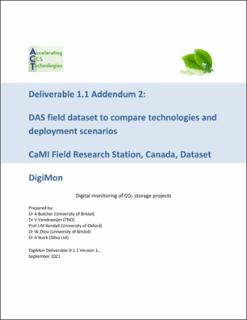| dc.description.abstract | This report describes a Distributed Acoustic Sensor (DAS) dataset acquired by DigiMon partners at the Containment and Monitoring Institute’s (CaMI) Field Research Station (FRS), Canada, between 6th to 10th September 2021. The field dataset contributes to the Deliverable D1.1 of the DigiMon project (DAS field dataset to compare technologies and deployment scenarios), which supports tasks 1.2 and 1.3 of the project.
The objective of the DigiMon project is to develop an early-warning system for Carbon Capture and Storage (CCS), which utilises a broad range of sensor technologies including DAS. While the system is primarily focused on CCS projects located in shallow offshore environment of the North Sea, it is also intended to be adaptable to onshore settings. Some of the key areas that the systems will monitor include the movement of the plume within the reservoir, well integrity, and CO2 leakage into the overburden. A combination of both active and passive seismic methods will be deployed to track the movement of CO2, for example seismic reflection to image seismic velocity changes and microseismics to capture fault activation. Acquiring seismic surveys using DAS is highly novel and offers cost-effective approach which can significantly increase the spatial resolution of the survey data; however, it has had limited use in the operational environment with several technical challenges still needing to be resolved, such as the transfer function of DAS.
CaMi FRS was selected as a field test location as the site has been specifically established to advance the development of monitoring technologies and protocols for CCS operations. At CaMi FRS, several different monitoring arrays have been installed which are directly applicable to DigiMon. This includes a 5km loop of DAS optical fibre, located with a 1.1 km surface trench and two observation wells, an array of surface and borehole geophone nodes, and 6 broadband seismometers operating by the University of Bristol. This monitoring infrastructure has been primarily installed to monitor CO2 injections into the Basal Belly River sandstone formation at approximately 300m below ground level. Injection of CO2 began at FRS in 2019 and during this time microseismic events have been recorded, albeit at shallower levels than the injection point. The site therefore provides a potential DAS dataset which contains both active and passive measurements for the DigiMon project. The abundance of instrumentation including DAS, geophones, and broadband seismometers provides a unique chance to test the capacity of these instruments for C02 storage monitoring. | en_US |
